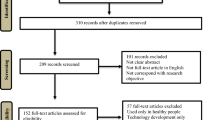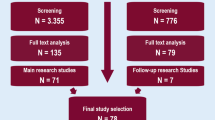Abstract
We conducted a systematic review of telerehabilitation (TR) interventions on children and young adults with multiple disabilities (MDs). This review aimed to (a) examine the effectiveness of telerehabilitation (TR) on adaptive skills that have been targeted for intervention, (b) describe the type of devices used in the intervention procedures, (c) summarize the outcomes, and (d) examine the consumer/professional satisfaction of TR. Eleven studies met inclusion criteria. Results suggested that TR is an effective tool in improving the adaptive skills of children and young adults with MDs. Boh consumers and professionals reported high levels of satisfaction and acceptance of TR services. Trends across different types of devices implemented in TR programs are considered and recommendations are made for future research.

Similar content being viewed by others
References
Bandara, W., Miskon, S., & Fielt, E. (2011). A systematic, tool-supported method for conducting literature reviews in IS. Information Systems Journal, 1–14.
Benham, S., & Gibbs, V. (2017). Exploration of the effects of telerehabilitation in a school-based setting for at-risk youth. International Journal of Telerehabilitation, 9, 39–46. https://doi.org/10.5195/ijt.2017.6215.
Brennan, D. M., Georgeadis, A. C., Baron, C. R., & Barker, L. M. (2004). The effect of videoconference-based telerehabilitation on story retelling performance by brain-injured subjects and its implications for remote speech-language therapy. Telemedicine Journal & e-Health, 10(2), 147–154.
Brennan, D. M., Mawson, S., & Brownsell, S. (2009). Telerehabilitation: enabling the remote delivery of healthcare, rehabilitation, and self management. Studies in Health Technology and Informatics, 145, 231–248.
Brennan, D., Tindall, L., Theodoros, D., Brown, J., Campbell, M., Christiana, D., ... & Lee, A. (2010). A blueprint for telerehabilitation guidelines. International journal of telerehabilitation, 2(2), 31.
Burdea, G.C., Jain, A., Rabin, B., Pellosie, R., Golomb, M. (2011). Long-term hand tele-rehabilitation on the playstation 3: benefits and challenges. Annual International Conference of the IEEE Engineering in Medicine and Biology Society, 33, 1835–1838.
Caprì, T., Fabio, R. A., Iannizzotto, G., & Nucita, A. (2020). The TCTRS project: a holistic approach for telerehabilitation in Rett syndrome. Electronics, 9, 491.
Castelli, I., Antonietti, A., Fabio, R. A., Lucchini, B., & Marchetti, A. (2013). Do Rett syndrome persons possess theory of mind? Some evidence from not-treated girls. Life Span and Disability, 16(2), 157–168.
Cottrell, M. A., Hill, A. J., O’Leary, S. P., Raymer, M. E., & Russell, T. G. (2017). Service provider perceptions of telerehabilitation as an additional service delivery option within an Australian neurosurgical and orthopaedic physiotherapy screening clinic: a qualitative study. Musculoskeletal Science and Practice, 32, 7–16. https://doi.org/10.1016/j.msksp.2017.07.008.
Cottrell, M. A., Swete-Kelly, P., Elwell, B., Hess, S., Litchfield, M. A., McLoughlinc, I., Tweedy, R., Raymerd, M., Hilla, A. J., & Russell, T. G. (2018). Agreement between telehealth and in-person assessment of patients with chronic musculoskeletal conditions presenting to an advanced-practice physiotherapy screening clinic. Musculoskeletal Science and Practice, 38, 99–105.
Fabio, R. A., & Caprì, T. (2017). The executive functions in a sample of Italian adults with ADHD: Attention, response inhibition and planning/organization. Mediterranean Journal of Clinical Psychology, 5(3). https://doi.org/10.6092/2282-1619/2017.5.1636.
Fabio, R. A., & Towey, G. E. (2018). Long-term meditation: the relationship between cognitive processes, thinking styles and mindfulness. Cognitive Processing, 19(1), 73–85. https://doi.org/10.1007/s10339-017-0844-3.
Fabio, R. A., & Urso, M. (2014). The analysis of attention network in ADHD, attention problems and typically developing subjects. Life Span and Disability, 17(2), 199–221.
Fabio, R. A., Billeci, L., Crifaci, G., Troise, E., Tortorella, G., & Pioggia, G. (2016). Cognitive training modifies frequency EEG bands and neuropsychological measures in Rett syndrome. Research in Developmental Disabilities, 73–85.
Fabio, R.A., Caprì, T., Lotan, M., Towey, G.E., & Martino, G. (2018a). Motor abilities are related to the specific genotype in Rett syndrome. In Kevin V. Urbano (Ed). Advances in genetics research. Volume 18. New York: Nova Science Publisher. ISBN: 978-153613265-6;978-153613264-9.
Fabio, R. A., Gangemi, A., Caprì, T., Budden, S., & Falzone, A. (2018b). Neurophysiological and cognitive effects of transcranial direct current stimulation in three girls with Rett syndrome with chronic language impairments. Research in Developmental Disabilities, 76, 76–87.
Fabio, R. A., Magaudda, C., Caprì, T., Towey, G., & Martino, G. (2018c). Choice behavior in Rett syndrome, the consistency parameter. Life Span and Disability, XXXI, 1, 47–62.
Fabio, R.A., Caprì, T., Nucita, A., Iannizzotto, G., & Mohammadhasani, N. (2019a). Eye gaze digital games to improve motivational and attentional ability in Rett syndrome. Journal of Special Education and Rehabilitation, 9(3-4), 105-126. DOI: https://doi.org/10.19057/jser.2019.43.
Fabio, R. A., Giannatiempo, S., & Caprì, T. (2019b). Attention and identification of the same and the similar visual stimuli in Rett syndrome. Life Span and Disabilities XXII, 1, 113–127.
Fabio, R. A., Gangemi, A., Semino, M., Vignoli, A., Canevini, M. P., Priori, A., Di Rosa, G., & Caprì, T. (2020). Effects of combined transcranial direct current stimulation with cognitive training in girls with Rett syndrome. Brain Sciences, 10, 276–290. https://doi.org/10.3390/brainsci10050276.
Gangemi, A., Caprì, T., Fabio, R.A., Puggioni, P., Falzone, A. M. & Martino, G. (2018). Transcranial direct current stimulation (tDCS) and cognitive empowerment for the functional recovery of diseases with chronic impairment and genetic etiopathogenesis. In Kevin V. Urbano (Ed). Advances in research. Volume 18. New York: Nova science Publisher. ISBN: 978-153613265-6;978-153613264-9.
Gibbs, V., & Toth-Cohene, S. (2011). Family-centered occupational therapy and telerehabilitation for children with autism spectrum disorders. Occupational Therapy In Health Care, 25(4), 298–314.
Golomb, M. R., McDonald, B. C., Warden, S. J., Yonkman, J., Saykin, A. J., Shirley, B., et al. (2010). In-home virtual reality videogame telerehabilitation in adolescents with hemiplegic cerebral palsy. Archives of Physical Medicine and Rehabilitation, 91, 1–8.
Gorsic, M., Cikajlo, I., Goljar, N., & Novak, D. (2017a). A multisession evaluation of an adaptive competitive arm rehabilitation game. Journal of Neuroengineering Rehabilitation, 14, 128.
Gorsic, M., Cikajlo, I., & Novak, D. (2017b). Competitive and cooperative arm rehabilitation games played by a patient and unimpaired person: effects on motivation and exercise intensity. Journal of Neuroengineering Rehabilitation, 14, 23.
Huber, M., Rabin, B., Docan, C., Burdea, G., Nwosu, M. E., Abdelbaky, M., & Golomb, M. R. (2014). PlayStation 3-based tele-rehabilitation for children with hemiplegia. Virtual Rehabilitation, pp. 105–112.
Individuals with Disabilities Education Act of 2004, P.L. 108–446.
Knutsen, J., Wolfe, A., Burke, B. L., Hepburn, S., Hepburn, S., Lindgren, S., & Coury, D. (2016). A systematic review of telemedicine in autism spectrum disorders. Review Journal of Autism and Developmental Disorders, 3(4), 330–344.
Mace, M., Kinany, N., Rinne, P., Rayner, A., Bentley, P., & Burdet, E. (2017). Balancing the playing field: collaborative gaming for physical training. Journal of Neuroengineering Rehabilitation, 14, 116.
McCue, M., Fairman A., & Pramuka, M. (2010). Enhancing quality of life through telerehabilitation. Physical Medicine and Rehabilitation Clinics of North America, 21(1), 195–205, 2010.
Mohammadhasani, N., Fardanesh, H., Hatami, J., Mozayani, N., & Fabio, R. A. (2018). The pedagogical agent enhances mathematics learning in ADHD students. Education and Information Technologies, 23(6), 2299–2308. https://doi.org/10.1007/s10639-018-9710-x.
Moher, D., Liberati, A., Tetzlaff, J., Altman, D. G., & Group, P. (2009). Preferred reporting items for systematic reviews and meta-analyses: the PRISMA statement. PLoS Medicine, 6(7), e1000097.
Nicola, K., Waugh, J., Charles, E., & Russell, T. (2018). The feasibility and concurrent validity of performing the movement assessment battery for children – 2nd edition via telerehabilitation technology. Research in Developmental Disabilities, 77, 40–48.
Novak, D., Nagle, A., Keller, U., & Riener, R. (2014). Increasing motivation in robot-aided arm rehabilitation with competitive and cooperative gameplay. Journal of Neuroengineering Rehabilitation, 11, 64.
Nyika, B. (2013). Telerehabilitation as means to improve elderlys ´ independence while living at home. Human Ageing Elder Services.
Oliver, M., Teruel, M. A., Molina, J. P., Romero-Ayuso, D., & Gonzalez, P. (2018). Ambient intelligence environment for home cognitive telerehabilitation. Sensors, 18, 3671. https://doi.org/10.3390/s18113671.
Peretti, A., Amenta, F., Tayebati, S. K., Nittari, G., & Mahdi, S. S. (2017). Telerehabilitation: review of the state-of-the-art and areas of application. JMIR rehabilitation and assistive technologies, 4(2), e7.
Popay, J., Roberts, H., Sowden, A., Petticrew, M., Arai, L., Rodgers, M., et al. (2006). Guidance on the conduct of narrative synthesis in systematic reviews. A product from the ESRC methods programme Version, 1, b92.
Pramuka, M., & van Roosmalen, L. (2009). Telerehabilitation technologies: accessibility and usability. International Journal of Telerehabilitation, 1(1), 85–97.
Pramuka, M., & van Roosmalen, L. (2015). Telerehabilitation technologies: accessibility and usability. International Journal of Telerehabilitation, 1(1), 25–36.
Putrino, D. (2019). Telerehabilitation and emerging virtual reality approaches to stroke rehabilitation. Current Opinion in Neurology, 27, 6, 631–6, 2014.
Quigley, S. P., Blevins, P. R., Cox, D. J., Brodhead, M. T., & Kim, S. Y. (2019). An evaluation of explicit ethical statements in telehealth research with individuals with autism spectrum disorder. Behavior Analysis: Research and Practice, 19(2), 123–135.
Rosso, G., Frisiello, A., Antonella, A., Trizio, M., Mosso, C. O., & Bazzan, M. (2018). Learning from professionals: exploring cognitive rehabilitation strategies for the definition of the functional requirements of a telerehabilitation platform. Computers in Biology and Medicine, 95, 288–297.
Schein, M. R., Schmeler, M. R., Holm, M. B., Saptono, A., & Brienza, D. M. (2010). Telerehabilitation wheeled mobility and seating assessments compared with in person. Archives of Physical Medicine and Rehabilitation, 91(6), 874–878.
Shamsuddina, S., Yussofa, H., Mohamed, S., Hanapiah, F. A., & Ainudin, A. H. (2015). Telerehabilitation service with a robot for autism intervention. Procedia Computer Science, 76, 349–354.
Sonido, M. T., Hwang, Y. I., Trollor, J. N., & Arnold, S. R. C. (2019). The mental well-being of informal carers of adults on the autism spectrum: a systematic review. Review Journal of Autism and Developmental Disorders, 1–15. https://doi.org/10.1007/s40489-019-00177-8.
Sutherland, R., Trembath, D., & Roberts, J. (2018). Telehealth and autism: a systematic search and review of the literature. International Journal of Speech-Language Pathology, 20, 324–336.
Tozzi, A. E., Carloni, E., Gesualdo, F., Russo, L., & Raponi, M. (2015). Attitude of families of patients with genetic diseases to use m-health technologies. Telemedicine and e-Health, 21, 2.
Woolf C, Caute A, Haigh Z, Galliers J, Wilson S, Kessie A, … Marshall J. (2015). Acomparison of remote therapy, face to face therapy and an attention control intervention for people with aphasia: a quasi-randomised controlled feasibility study. Clinical Rehabilitation. https://doi.org/10.1177/0269215515582074.
Author information
Authors and Affiliations
Contributions
Rosa Angela Fabio had the idea for the article; Tindara Caprì, Andrea Nucita, Giancarlo Iannizzotto, and Rosa Angela Fabio performed the literature search and data analysis; Fabrio Stasolla, Martina Semino, Alberto Romano, Virginia Canegallo, and Samantha Giannatiempo drafted and critically revised the work.
Corresponding author
Ethics declarations
Conflict of Interest
The authors declare that they have no conflict of interest.
Ethical Approval
This article does not contain any studies with human participants or animals performed by any of the authors.
Additional information
Publisher’s Note
Springer Nature remains neutral with regard to jurisdictional claims in published maps and institutional affiliations.
Rights and permissions
About this article
Cite this article
Caprì, T., Nucita, A., Iannizzotto, G. et al. Telerehabilitation for Improving Adaptive Skills of Children and Young Adults with Multiple Disabilities: a Systematic Review. Rev J Autism Dev Disord 8, 244–252 (2021). https://doi.org/10.1007/s40489-020-00214-x
Received:
Accepted:
Published:
Issue Date:
DOI: https://doi.org/10.1007/s40489-020-00214-x




